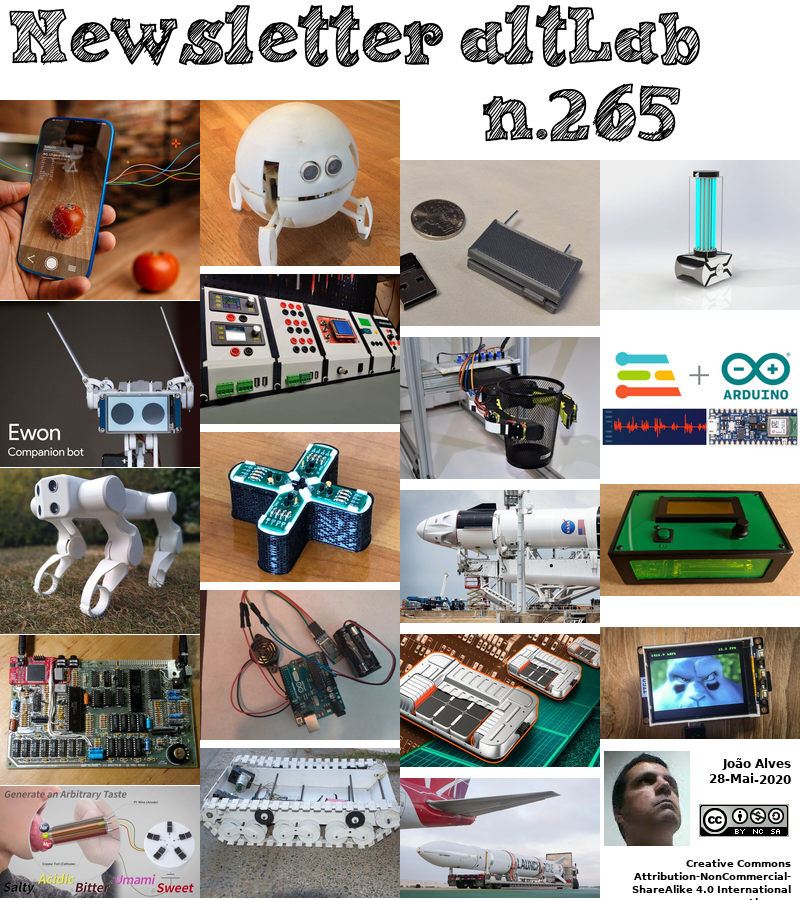2020-05-28 - Nº 265
Editorial
Esta é a Newsletter Nº 265 que se apresenta com o mesmo formato que as anteriores. Se gostar da Newsletter partilhe-a!
Todas as Newsletters encontram-se indexadas no link.
Esta Newsletter tem os seguintes tópicos:
Faz hoje anos que nascia, em 1895, o astrónomo alemão Rudolph Minkowski. Ele estudou espectros, distribuições e movimentos de nebulosas planetárias e mais que duplicou o número conhecido. Ele investigou novas e super-novas e seus remanescentes, especialmente a física e a expansão da Nebulosa de Câncer (um remanescente pulsar). Com Walter Baade, Minkowski dividiu as super-novas nos tipos I e II com base nas características espectrais e identificaram contra-partes ópticas de muitas das primeiras fontes de rádio, incluindo Cygnus A, Virgo A (M87), Perseus A (NGC 1275) e Centaurus A (NGC 5128). Pouco antes de se reformar, ele encontrou o que foi durante anos o maior desvio para o vermelho conhecido numa galáxia. Ele foi premiado com a Medalha Bruce em 1961 por serviços distintos à astronomia.
Faz também hoje anos que nascia, em 1911, o físico americano Alfred O. C. Nier. Ele refinou o processo espectrométrico de massa para distinguir isótopos. Em 1934, com Lyman T. Aldrich, ele aplicou o decaimento do potássio-40 ao árgon-40 para medir a idade dos materiais geológicos. Ele descobriu (1936-38) uma série de novos isótopos de tão baixa abundância que não tinham sido detectados anteriormente, incluindo S36, Ca46, Ca48 e Os186. Nier mostrou como a proporção de isótopos radioactivos de urânio e seus produtos de decomposição era um segundo método para estimar a idade das rochas. Durante a Segunda Guerra Mundial, com outros, ele mostrou (1940) que o urânio-235 mais raro sofre fissão, o que não é comum no U-238.
Faz igualmente hoje anos que nascia, em 1917, o inventor e escritor americano Edgar Villchur. Ele ficou conhecido pela sua invenção em 1954 do altifalante de suspensão acústica que revolucionou o campo de equipamentos de alta fidelidade.
Por fim, faz hoje anos que nascia, em 1930, o astrónomo americano Frank Drake. Ele formulou a Equação com o seu nome para estimar o número de civilizações tecnológicas que podem existir na galáxia Via Láctea, N = R * × fp × ne × fl × fi × fc × L. Usando suposições plausíveis para os parâmetros, Drake concluiu que talvez 10 planetas na nossa galáxia possam ter sinais detectáveis originários da vida. Em 1960, Drake liderou a primeira pesquisa, o Projecto Ozma, de dois meses, para escutar padrões em ondas de rádio com um padrão complexo e ordenado, que se supõe representar mensagens de alguma inteligência extraterrestre. Carl Sagan e Drake projectaram as placas do Pioneer 10 e Pioneer 11 com o objectivo de cumprimentar e informar qualquer vida extraterrestre que pudesse encontrar os vasos depois que eles deixassem o sistema solar. Foi também fundador da iniciativa SETI (search for extraterrestrial intelligence).
Nesta semana que passou a fundação Raspberry Pi anunciou uma nova versão da sua placa Raspberry Pi 4. Tendo o Raspberry Pi 4 quase um ano e tendo vendas de certa de 3 milhões de unidades vendidas foi apresentada mais uma variante deste modelo - uma placa Raspberry Pi 4 com 8GB de memória. Isto foi possível, porque o chip usado no Raspberry Pi 4 permite endereçar até 16GB de memória. Para comportar o necessário aumento de consumo energético foram também feitas alterações no sistema de alimentação da placa.
Também nesta que passou, abortou a tentativa de lançar pela primeira vez para o espaço astronautas dentro dum veiculo espacial construído pela SpaceX. O Crew Dragon deveria ter sido lançado com os astronautas Bob Behnken e Doug Hurley esta quarta-feira com destino à estação espacial Internacional mas as condições meteorológicas adversas impediram o lançamento. Vai ser feito uma nova tentativa já neste sábado 30 de Maio as 15:22 EST.
Por fim, nesta semana que passou a tentativa de lançamento do foguetão LauncherOne da Virgin Orbit, a partir de um avião, falhou. Após o foguetão ter sido largado do Boeing 747 - "Cosmic Girl" - não seguiu com o plano de voo e acabou por cair. O foguetão deveria cair por alguns segundos antes que o primeiro de seus dois estágios se inflamasse e o impulsionasse pela costa em direcção ao pólo sul para a inserção de sua carga de demonstração numa órbita baixa da Terra.
Na Newsletter desta semana apresentamos diversas noticias, artigos científicos assim como projetos de maker. São apresentadas as revistas MagPI Nº 94 de Junho e newselectronics de 26 de Maio.
 João Alves ([email protected])
João Alves ([email protected])
O conteúdo da Newsletter encontra-se sob a licença  Creative Commons Attribution-NonCommercial-ShareAlike 4.0 International License.
Creative Commons Attribution-NonCommercial-ShareAlike 4.0 International License.
Novidades da Semana
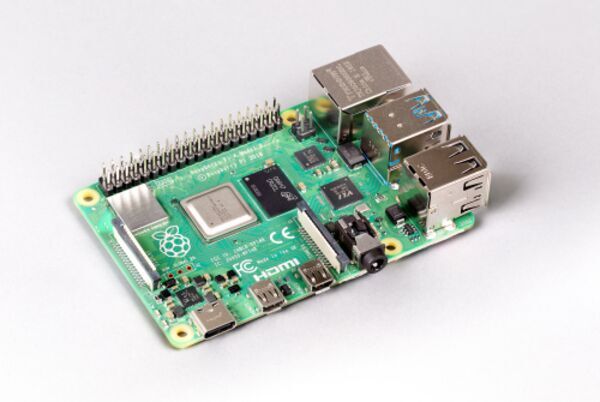
8GB Raspberry Pi 4 on sale now at $75
"Raspberry Pi 4 is almost a year old, and it’s been a busy year. We’ve sold nearly 3 million units, shipped a couple of minor board revisions, and reduced the price of the 2GB variant from $45 to $35. On the software side, we’ve done enormous amounts of work to reduce the idle and loaded power consumption of the device, passed OpenGL ES 3.1 conformance, started work on a Vulkan driver, and shipped PXE network boot mode and a prototype of USB mass storage boot mode – all this alongside the usual round of bug fixes, feature additions, and kernel version bumps. While we launched with 1GB, 2GB and 4GB variants, even at that point we had our eye on the possibility of an 8GB Raspberry Pi 4. We were so enthusiastic about the idea that the non-existent product made its way into both the Beginner’s Guide and the compliance leaflet. The BCM2711 chip that we use on Raspberry Pi 4 can address up to 16GB of LPDDR4 SDRAM, so the real barrier to our offering a larger-memory variant was the lack of an 8GB LPDDR4 package." [...]
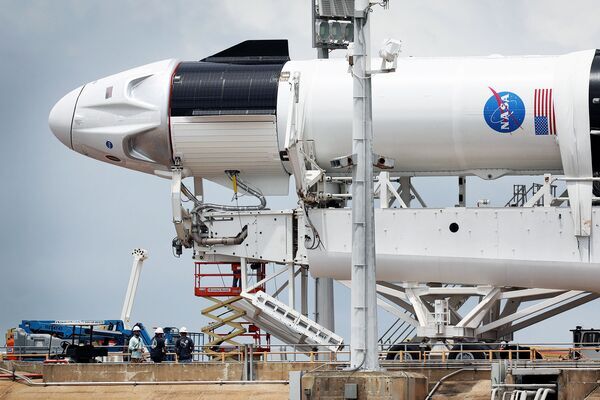
Weather Delays the SpaceX Crew Dragon Launch
"The historic launch planned for Wednesday gets pushed back due to stormy conditions, but the launch window remains open. SpaceX and NASA will try again Saturday. ON WEDNESDAY AFTERNOON, veteran astronauts Bob Behnken and Doug Hurley were scheduled to fly to the International Space Station in a SpaceX Crew Dragon capsule. The Demo-2 mission was going to be the first crewed mission for SpaceX and the first time NASA astronauts have launched from the US in nine years. But the world will have to wait a few more days to see it happen. Just 17 minutes before launch, SpaceX scrubbed the mission due to bad weather around the launch site and along the capsule’s flight path." [...]

Richard Branson’s Virgin Orbit rocket test launch fails
"Richard Branson’s Virgin Orbit has failed in its first test launch of a new rocket carried by a Boeing 747 and released over the Pacific Ocean off the coast of southern California. The inaugural launch had appeared to be going well until moments after the rocket was dropped from beneath the left wing of the jumbo jet dubbed “Cosmic Girl”. The launch failure is the latest setback for Branson, who recently announced he was selling $500m (£405m) worth of shares in his space travel business Virgin Galactic – a sister company of Orbit – to help prop up his ailing aviation and leisure businesses. In its official Twitter commentary on the launch, Virgin Orbit said: “We’ve confirmed a clean release from the aircraft. However, the mission terminated shortly into the flight. Cosmic Girl and our flight crew are safe and returning to base.” There was no immediate explanation for what went wrong with the rocket, which carried a test satellite." [...]
Outras Notícias
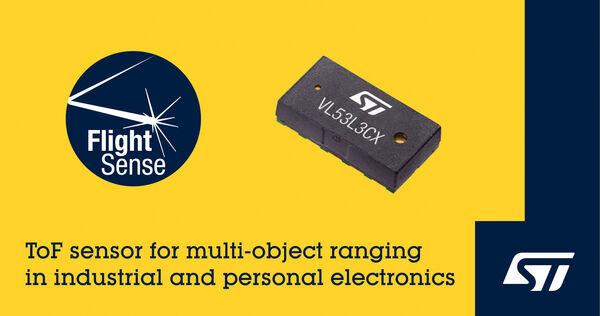
STMicroelectronics’ Latest Time-of-Flight Sensor Enables Multi-Object Ranging for Next-Gen Industrial and Personal Electronics Applications
"STMicroelectronics, a world leader in Time-of-Flight (ToF) solutions with over one billion devices delivered for various applications, has extended the capabilities of its FlightSense™ ToF ranging sensors by introducing the VL53L3CX with patented histogram algorithms that allow measuring distances to multiple objects as well as increasing accuracy. The VL53L3CX measures object ranges from 2.5cm to 3m, unaffected by the target color or reflectance, unlike conventional infrared sensors. This allows designers to introduce powerful new features to their products, such as enabling occupancy detectors to provide error-free sensing by ignoring unwanted background or foreground objects, or reporting the exact distances to multiple targets within the sensor’s field-of-view. The ST patented histogram algorithms increase cover-glass crosstalk immunity and allow real-time smudge compensation preventing external contamination from adversely affecting the ranging accuracy of, for example, vacuum cleaners or equipment that may be used in a dusty industrial environment. Ranging under ambient lighting is also improved. In addition, the VL53L3CX has superior linearity that increases short-distance measurement accuracy enhancing wall tracking, faster cliff detection, and obstacle avoidance in equipment such as service robots and vacuum cleaners, markets in which ST has already enjoyed considerable commercial success." [...]
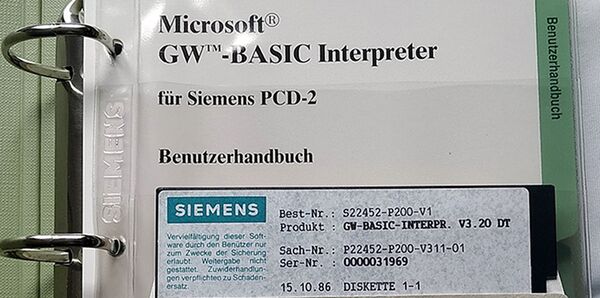
Microsoft Open-Sources GW-BASIC
"We are excited to announce the open-sourcing of Microsoft GW-BASIC on GitHub! Yes, seriously Why? Since re-open-sourcing MS-DOS 1.25 & 2.0 on GitHub last year, we’ve received numerous requests to also open-source Microsoft BASIC. Well, here we are! The Source These sources, as clearly stated in the repo’s readme, are the 8088 assembly language sources from 10th Feb 1983, and are being open-sourced for historical reference and educational purposes. This means we will not be accepting PRs that modify the source in any way." [...]
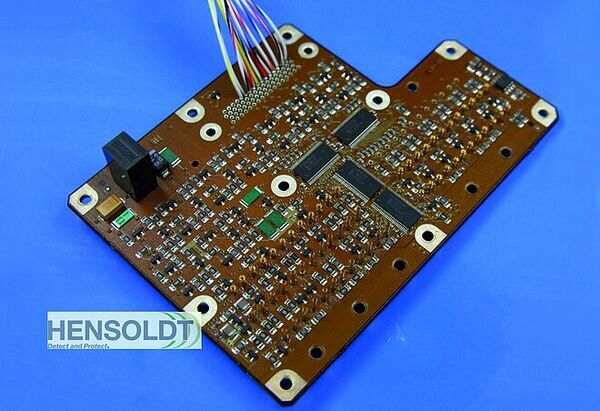
HENSOLDT and Nano Dimension Achieve Breakthrough in Electronics 3D Printing
"Sensor solutions provider HENSOLDT together with the leading Additively Manufactured Electronics (AME)/Printed Electronics (PE) provider, Nano Dimension, has achieved a major breakthrough on its way to utilizing 3D printing in the development process of high-performance electronics components. Utilizing a newly developed dielectric polymer ink and conductive ink from Nano Dimension, HENSOLDT succeeded in assembling the world-wide first 10-layer printed circuit board (PCB) which carries high-performance electronic structures soldered to both outer sides. Until now, 3D printed boards could not bear the soldering process necessary for two sided population of components. “Military sensor solutions require performance and reliability levels far above those of commercial components.” says HENSOLDT CEO, Thomas Müller. “To have high-density components quickly available with reduced effort by means of 3D printing gives us a competitive edge in the development process of such high-end electronic systems.” “Nano Dimension’s relationship with HENSOLDT is the type of partnership with customers we are striving for,” commented Yoav Stern, Nano Dimension President & CEO. “Working together and learning from HENSOLDT led us to reach a first-of-its-kind in-depth knowledge of polymer materials applications." [...]

New Arm IP delivers true digital immersion for the 5G era
"News Highlights: Arm Cortex-A78 CPU: Transforming next-generation smartphone experiences with 20% sustained performance gains Arm Cortex-X Custom program: New program offers custom Cortex solutions and delivers the Arm Cortex-X1 with a 30% increase in peak performance Arm Mali-G78 GPU: The highest-performing Mali GPU based on Valhall architecture with a 25% increase in performance Arm Ethos-N78 NPU: Unprecedented machine learning capability with a 25% improvement in performance efficiency During this unprecedented global health crisis, we have experienced rapid societal changes in how we interact with and rely on technology to connect, aid, and support us. As a result of this we are increasingly living our lives on our smartphones, which have been essential in helping feed our families through application-based grocery or meal delivery services, as well as virtually seeing our colleagues and loved ones daily. Without question, our Arm-based smartphones are the computing hub of our lives. However, even before this increased reliance on our smartphones, there was already growing interest among users to explore the limits of what is possible. The combination of these factors with the convergence of 5G and AI, are generating greater demand for more performance and efficiency in the palm of our hands. But more performance and efficiency are only meaningful if your smartphone is optimized to deliver the best experiences on the applications that matter to you most." [...]

Qualcomm Introduces the World’s Most Advanced Mobile Wireless Connectivity Portfolio with 6 GHz Wi-Fi 6E and Bluetooth 5.2
"Qualcomm FastConnect 6900 and 6700 combine leading implementations of next generation connectivity technologies to deliver unprecedented performance and mobile experiences across smartphone tiers Qualcomm Technologies, Inc., a subsidiary of Qualcomm Incorporated, launches a flagship portfolio of mobile connectivity systems that represent the most advanced Wi-Fi 6E offerings of their kind. Building upon our leading Wi-Fi 6 and Bluetooth audio technology features, the Qualcomm® FastConnect™ 6900 and Qualcomm® FastConnect™ 6700 mobile connectivity systems feature the fastest available Wi-Fi speeds in the industry (up to 3.6 Gbps) on a mobile Wi-Fi offering, VR-class low latency and Bluetooth advancements delivering immersive audio experiences for classic and emerging LE Audio use cases. “With the introduction of the FastConnect 6900 and 6700 solutions, Qualcomm Technologies is redefining the mobile experience by extending the power of Wi-Fi 6 into the 6 GHz band and advancing wireless audio with cutting-edge integrated Bluetooth 5.2 features,” said Dino Bekis, vice president and general manager, mobile and compute connectivity, Qualcomm Technologies, Inc. “These innovations enable us to further break away from the pack and deliver a connectivity portfolio optimized to accelerate global adoption across multiple smartphone tiers.” “Wi-Fi 6E delivers an unprecedented improvement in capacity to meet the rapid growth of connected devices and data demand. The introduction of supporting chipsets so soon after the FCC ruling ensures customers will see the benefits quickly and is an indicator of both Qualcomm Technologies’ investment and broad industry collaboration,” said Geoff Blaber, vice president, research, Americas, CCS Insights. “Wi-Fi Alliance® members have mobilized around 6 GHz in an unprecedented way, and we’re excited to see Wi-Fi 6E solutions rapidly coming to market with the availability of new unlicensed spectrum in the U.S.,” said Kevin Robinson, Senior VP of Marketing, Wi-Fi Alliance. “Solutions like these from Qualcomm will help users fully experience Wi-Fi® in 6 GHz and quickly benefit from faster speeds, higher capacity, and lower latency applications.” Next-Generation Wi-Fi 6E for Mobile and Computing New portfolio extends advanced Wi-Fi 6 feature implementations into the 6 GHz band." [...]
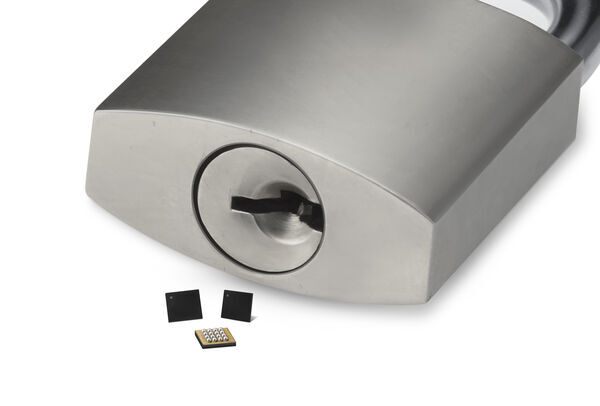
Samsung Elevates Data Protection for Mobile Devices with New Security Chip Solution
"The new EAL 6+ certified-SE chip and dedicated software is a standalone security solution for mobile devices and other applications Samsung Electronics, a world leader in advanced semiconductor technology, today introduced a standalone turnkey security solution comprised of a Secure Element (SE) chip (S3FV9RR) and enhanced security software that offers protection for tasks such as booting, isolated storage, mobile payment and other applications. The latest security chip is Common Criteria Evaluation Assurance Level (CC EAL) 6+ certified, the highest level acquired by a mobile component. “In this era of mobility and contact-less interactions, we expect our connected devices, such as smartphones or tablets, to be highly secure so as to protect personal data and enable fintech activities such as mobile banking, stock trading and cryptocurrency transactions,” said Dongho Shin, senior vice president of System LSI marketing at Samsung Electronics. “With the new standalone security element solution (S3FV9RR), Samsung is mounting a powerful deadbolt on smart devices to safeguard private information.” Samsung’s new security solution is an enhanced turnkey that follows the first-generation solution (S3K250AF) announced in February. The new security solution is a state-of-the-art component that offers higher assurance levels than its predecessor’s CC EAL 5+ with an industry-leading CC EAL 6+ certified-hardware secure element, S3FV9RR, and powerful security software. CC EAL 6+ is utilized in applications that demand the most stringent security requirements in the market such as flagship smartphones, e-passports and hardware wallets for cryptocurrency." [...]
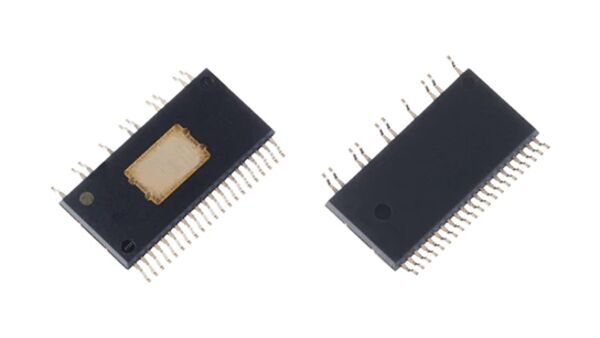
Toshiba’s 600V Small Intelligent Power Device Helps Lower Motor Power Dissipation
"Toshiba Electronic Devices & Storage Corporation (“Toshiba”) has launched “TPD4162F,” a high-voltage intelligent power device (IPD) housed in a small surface mount package, designed to drive motors in products such as air conditioners, air purifiers and pumps. Mass production shipments start today. Fabricated with a new process, TPD4162F reduces power dissipation about 10% lower than that of Toshiba’s current IPD, TPD4152F—which will help to lower the power dissipation of devices into which it is integrated. TPD4162F has various control circuits, and IGBTs and FRDs are installed on output stage. This supports direct drive of a brushless DC motor with square wave input signals from either a Hall sensor or a Hall IC without requiring a PWM controller IC. Various built-in protection circuits[3] reduce the peripheral circuit count." [...]
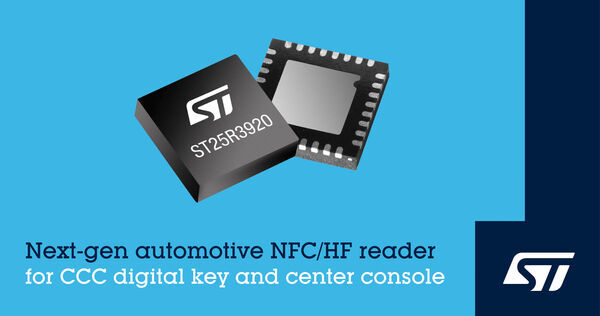
STMicroelectronics Reveals Next-Generation NFC Reader IC for Digital Car Keys
"STMicroelectronics has extended its portfolio of ST25R NFC reader ICs with a new addition to the successful digital car key line, the ST25R3920. The new device introduces enhanced features for stronger performance, including rapid key response and extended range. Digital keys let drivers conveniently lock and unlock their cars using their smartphones, and support added-value features including easy sharing and management of access privileges for other users such as friends or valets. They could also enable new vehicle-ownership models, including car subscription services. The Car Connectivity Consortium (CCC) Digital Key Release 2.0, relaying on NFC, even offers the ability to use the key while the phone battery is so low that normal device operation is disabled. Having pioneered NFC-access roll-out in cars over the past years and currently supplying well-known US, European, and Asian automotive brands, ST as a leader in digital car-key technology is now extending the state-of-the-art with the ST25R3920." [...]
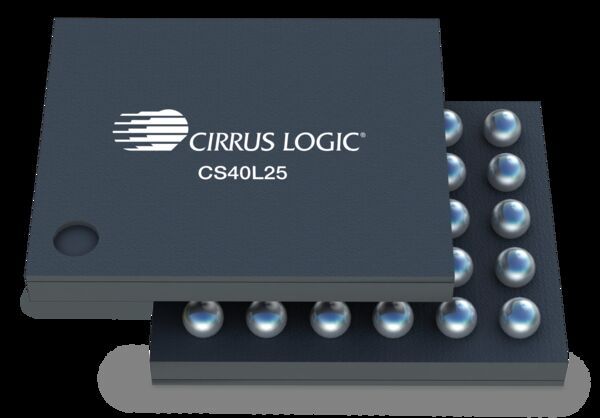
Cirrus Logic Launches Advanced Haptic and Sensing Technology Solutions for Richer, Immersive User Experiences
"New Haptic ICs Enable Increased Functionality and Sleek Buttonless Designs for Variety of Smartphones, PCs, Wearables, Gaming, Virtual Reality and Automotive Applications With the goal of elevating the user experience for a wide range of consumer devices, Cirrus Logic (Nasdaq: CRUS) is leveraging its technology leadership in low-power, low-latency mixed-signal processing to develop an advanced product portfolio of haptic and sensing integrated circuits (ICs). Cirrus Logic’s haptic products and sophisticated haptic feedback technology enable sleeker, more robust end products with fewer mechanical controls for new responsive and immersive user experiences. Already a leader in haptic technology for smartphones, Cirrus Logic is expanding its haptics and sensing expertise to provide an immersive touch experience for applications in automotive, augmented and virtual reality, gaming, personal computers and wearables. The new Cirrus Logic CS40L25 family of boosted haptic drivers enables OEMs to create customized user experiences beyond the single-action response of today’s mechanical buttons. “Consumer devices have become slimmer and more display-driven, and advanced haptics are evolving to offer consumers a richer, more tactile experience,” said Harsha Rao, Cirrus Logic manager, Haptics and Sensing. “Cirrus Logic’s haptic solutions feature low-latency, boost voltage and closed-loop control algorithms that enable customized waveforms to trigger a variety of fast, unique haptic feedback responses." [...]
Ciência e Tecnologia
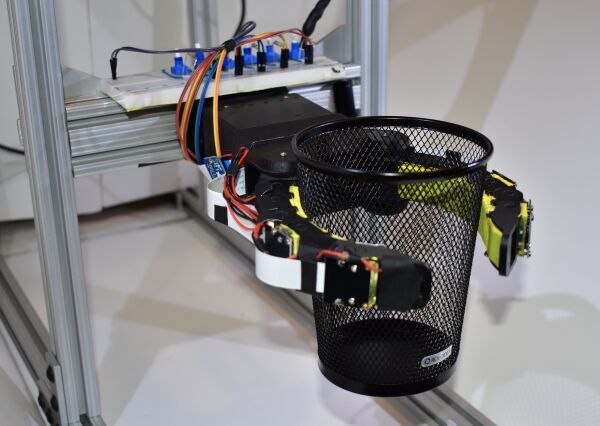
Giving soft robots feeling
"In a pair of papers from MIT CSAIL, two teams enable better sense and perception for soft robotic grippers. One of the hottest topics in robotics is the field of soft robots, which utilizes squishy and flexible materials rather than traditional rigid materials. But soft robots have been limited due to their lack of good sensing. A good robotic gripper needs to feel what it is touching (tactile sensing), and it needs to sense the positions of its fingers (proprioception). Such sensing has been missing from most soft robots. In a new pair of papers, researchers from MIT’s Computer Science and Artificial Intelligence Laboratory (CSAIL) came up with new tools to let robots better perceive what they’re interacting with: the ability to see and classify items, and a softer, delicate touch." [...]
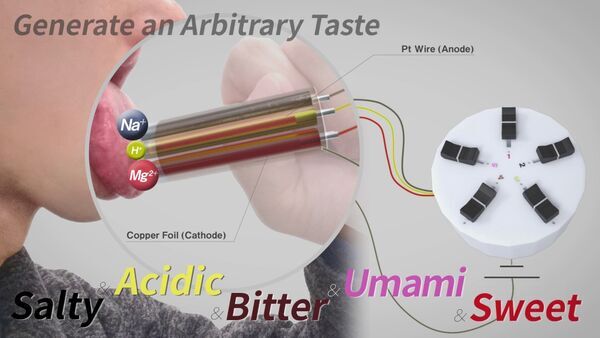
Developing a technology that can share tastes without the risk of infection: Prof. Homei Miyashita has developed a taste display that expresses an arbitrary taste
"Dr. Homei Miyashita, Professor at the Department of Frontier Media Science, School of Interdisciplinary Mathematical Sciences, Meiji University has developed a taste display that can express an arbitrary taste. In this study, a set of five gels, each of which contains an electrolyte that causes the tongue to sense the five basic tastes (sweet, acidic, salty, bitter, and umami) is applied to the tongue. The application of different voltages to these gels make ions within them move and thus the amounts of different ions that touch the tongue can be controlled. That makes it possible to freely adjust the proportions of the five basic tastes sensed by the tongue (patent pending). This technology only allows for the communication of taste information without the need for the movement of people or food and drink. Therefore various applications are expected in the future, including sharing of tastes without the risk of infection." [...]
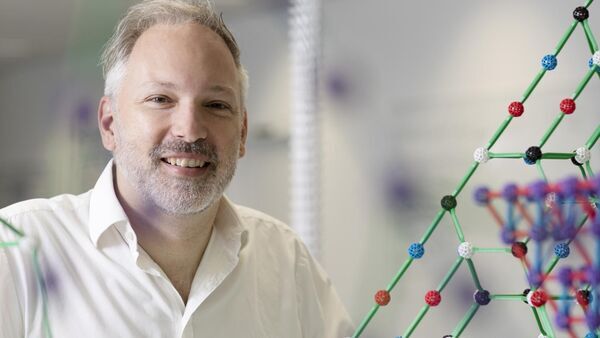
Stitch in time: how a quantum physicist made new code from old tricks
"Building large-scale quantum computers will require suppression of errors. Dr Ben Brown has used a neat trick to apply powerful 3D error-suppression codes in a 2D architecture, something one industry insider said many thought was impossible. A scientist at the University of Sydney has achieved what one quantum industry insider has described as “something that many researchers thought was impossible”. Dr Benjamin Brown from the School of Physics has developed a type of error-correcting code for quantum computers that will free up more hardware to do useful calculations. It also provides an approach that will allow companies like Google and IBM to design better quantum microchips. He did this by applying already known code that operates in three-dimensions to a two-dimensional framework." [...]
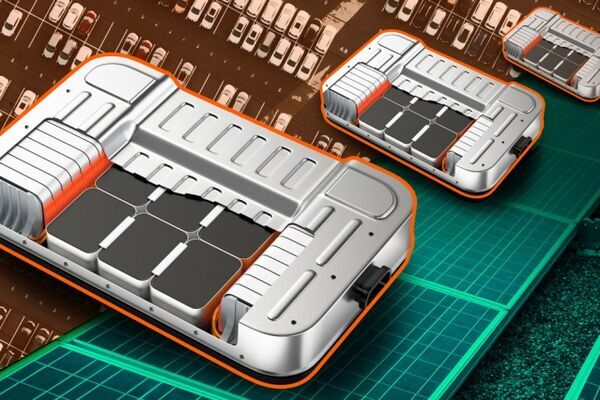
Solar energy farms could offer second life for electric vehicle batteries
"Modeling study shows battery reuse systems could be profitable for both electric vehicle companies and grid-scale solar operations. As electric vehicles rapidly grow in popularity worldwide, there will soon be a wave of used batteries whose performance is no longer sufficient for vehicles that need reliable acceleration and range. But a new study shows that these batteries could still have a useful and profitable second life as backup storage for grid-scale solar photovoltaic installations, where they could perform for more than a decade in this less demanding role. The study, published in the journal Applied Energy, was carried out by six current and former MIT researchers, including postdoc Ian Mathews and professor of mechanical engineering Tonio Buonassisi, who is head of the Photovoltaics Research Laboratory. As a test case, the researchers examined in detail a hypothetical grid-scale solar farm in California. They studied the economics of several scenarios: building a 2.5-megawatt solar farm alone; building the same array along with a new lithium-ion battery storage system; and building it with a battery array made of repurposed EV batteries that had declined to 80 percent of their original capacity, the point at which they would be considered too weak for continued vehicle use." [...]
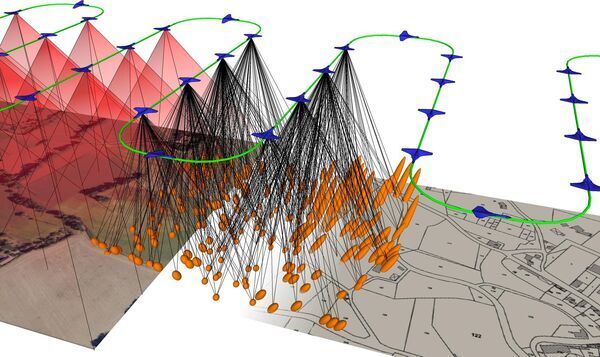
New and improved drone mapping software
"For his thesis, an EPFL PhD student has enhanced the accuracy and reliability of drone mapping – a technique that is gaining traction across many sectors of society. Making drone mapping more accurate is one of the goals of the Geodetic Engineering Laboratory (Topo), which is run by Bertrand Merminod within EPFL's School of Architecture, Civil and Environmental Engineering (ENAC). Drones are not only toys for big and little kids – they also serve many practical purposes. They can be used to monitor dams and railroads in order to prevent accidents, or to create 3D digital copies of historical monuments in case they are accidentally or deliberately destroyed. They can also capture images from one season to the next in order to measure soil erosion. "It's very important to be as accurate as possible," says Emmanuel Cledat, who has just completed his PhD thesis at the Topo lab." [...]

Researchers just recorded world's fastest internet speeds using a single optical chip
"Researchers from RMIT, Monash and Swinburne universities have achieved the world’s fastest internet data speed - enough to download 1000 HD movies in a split second - using a single optical chip. The ground-breaking results published in Nature Communications could fast-track Australia’s telecommunications capacity and that of other countries also struggling with demand on internet infrastructure. The research team led by Monash University’s Dr Bill Corcoran, RMIT’s Distinguished Professor Arnan Mitchell and Swinburne’s Professor David Moss recorded a data speed of 44.2 Terabits per second (Tbps) from a single light source. Importantly, said Mitchell, these speeds were achieved by attaching their new device to existing fibre-optic technology like that used across Australia's National Broadband Network (NBN). He said the future ambition of the project was to scale up the current transmitters from hundreds of gigabytes per second towards tens of terabytes per second without increasing size, weight or cost. “Long-term, we hope to create integrated photonic chips that could enable this sort of data rate to be achieved across existing optical fibre links with minimal cost,” Mitchell said." [...]
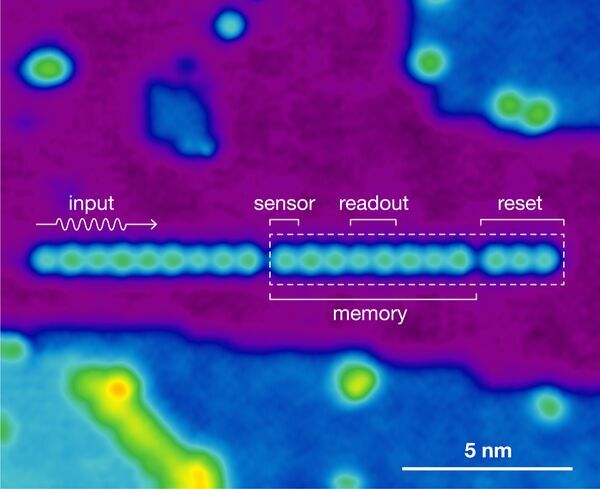
Researchers build sensor consisting of only 11 atoms
"Researchers at Delft University of Technology have developed a sensor that is only 11 atoms in size. The sensor is capable of capturing magnetic waves and consists of an antenna, a readout capability, a reset button and a memory unit. The researchers hope to use their atomic sensor to learn more about the behaviour of magnetic waves, so that hopefully such waves can be used in green ICT applications one day. In theory, we can make electronic data processing much more efficient by switching to spintronics. Instead of using electrical signals, this technology makes use of magnetic signals to transmit data. Unfortunately, magnetism tends to get incredibly complicated, especially at the tiny scale of our computer chips." [...]
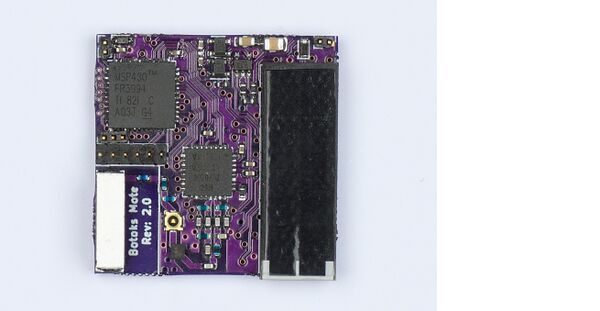
Intermittent computing to replace trillions of batteries
"Few things change as fast as the future of computing. Most experts and large chip manufacturers agree that the world’s ever-increasing appetite for computing will culminate in an omnipresent Internet of Things – trillions of devices taking sensor measurements, performing calculations and communicating with each other. Intermittent computing will not change that, but it may transform how these devices are powered, changing their operation at a fundamental level. ‘Batteries are the biggest threat to a sustainable Internet of Things, or to computing in general,’ says Przemyslaw Pawelczak, assistant professor in the Embedded and Networked Systems Group at TU Delft. ‘The one big advantage of a battery is that it provides continuous power, allowing for uninterrupted operation of a device. But a battery is hazardous, bulky and it has a chemical impact on the environment." [...]
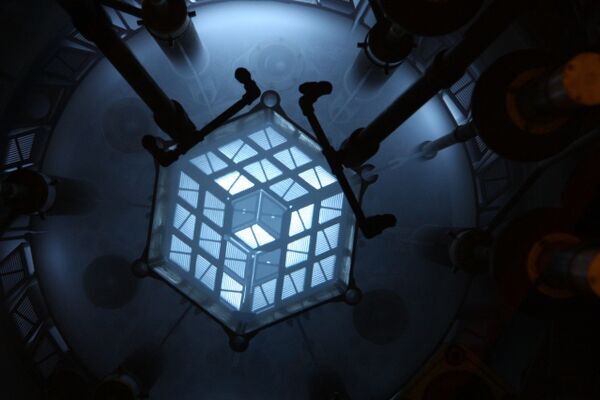
Making nuclear energy cost-competitive
"Three MIT teams to explore novel ways to reduce operations and maintenance costs of advanced nuclear reactors. Nuclear energy is a low-carbon energy source that is vital to decreasing carbon emissions. A critical factor in its continued viability as a future energy source is finding novel and innovative ways to improve operations and maintenance (O&M) costs in the next generation of advanced reactors. The U.S. Department of Energy’s Advanced Research Projects Agency-Energy (ARPA-E) established the Generating Electricity Managed by Intelligent Nuclear Assets (GEMINA) program to do exactly this. Through $27 million in funding, GEMINA is accelerating research, discovery, and development of new digital technologies that would produce effective and sustainable reductions in O&M costs. Three MIT research teams have received APRA-E GEMINA awards to generate critical data and strategies to reduce O&M costs for the next generation of nuclear power plants to make them more economical, flexible, and efficient." [...]
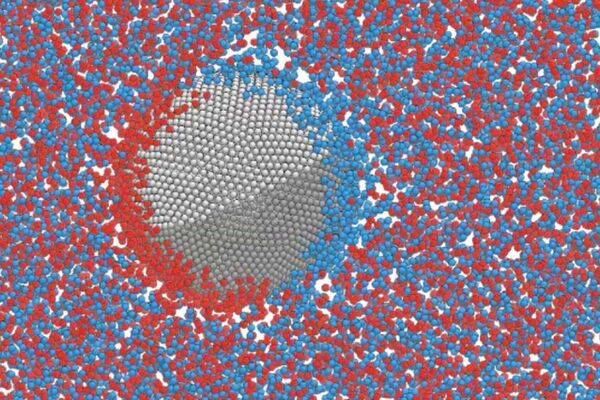
Study finds electrical fields can throw a curveball
"Particle-scale phenomenon akin to the swerving of a curveball could allow selective separation of suspended nanomaterials. MIT researchers have discovered a phenomenon that could be harnessed to control the movement of tiny particles floating in suspension. This approach, which requires simply applying an external electric field, may ultimately lead to new ways of performing certain industrial or medical processes that require separation of tiny suspended materials. The findings are based on an electrokinetic version of the phenomenon that gives curveballs their curve, known as the Magnus effect. Zachary Sherman PhD ’19, who is now a postdoc at the University of Texas at Austin, and MIT professor of chemical engineering James Swan describe the new phenomenon in a paper published this week in the journal Physical Review Letters. The Magnus effect causes a spinning object to be pulled in a direction perpendicular to its motion, as in the curveball; it is based on aerodynamic forces and operates at macroscopic scales — i.e." [...]
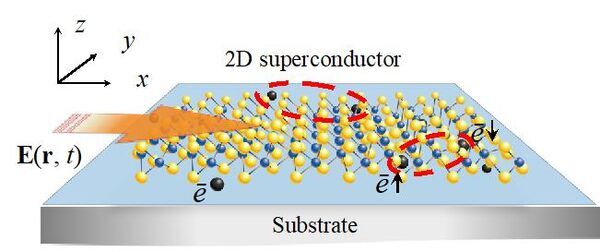
Controlling Superconductors with Light
"New theoretical study shows how to use Terahertz light to peep in the secrets of two-dimensional superconductors A researcher at the Center for Theoretical Physics of Complex Systems, within the Institute for Basic Science (IBS, South Korea), Professor Ivan Savenko, has reported a conceptually new method to study the properties of superconductors using optical tools. The theory was published in Physical Review Letters and co-authored by Doctor Vadim Kovalev, physicist at the A.V. Rzhanov Institute of Semiconductor Physics (Russia). Below some temperature, the resistivity of a material can disappear, and thus, superconducting properties emerge. These are usually extremely low temperatures, between -200°C and -272°C, where commonly unbound electrons suddenly change their behavior and pair up, forming Cooper pairs. This transition manifests itself with supercurrents, which can circulate in the material forever without losses." [...]

Quantum simulators for gauge theories
"A new study by SISSA and ICTP shows how atomic physics experiments allow for simulation of the forces that govern our universe more efficiently than traditional calculators do To simulate in a laboratory what happens in particle accelerators has been an ambitious goal in the study of the fundamental forces of nature pursued by highenergy physicists for many years. Now, thanks to research conducted by the groups of statistical physics of SISSA – Scuola Internazionale Superiore di Studi Avanzati and the “Abdus Salam” International Centre for Theoretical Physics (ICTP), that goal is closer to reach. “We have dealt with a gauge theory, more precisely the Schwinger model, which mathematically describes the interaction between microscopic charged particles, like electrons and positrons, and an electric field in one spatial dimension," said Federica Surace, PhD student at SISSA and lead author of the research, recently published on Physical Review X. “We have shown that this theory can be simulated in an experiment with ultracold atoms better than what calculators have done to date. This experiment was conducted in Prof. Lukin’s laboratory at Harvard University.” Investigating the fundamental forces of nature The study, to which PhD students Paolo P. Mazza, Giuliano Giudici, Alessio Lerose, and their supervisors Andrea Gambassi of SISSA and Marcello Dalmonte of ICTP also contributed, shows that the experiment carried out overseas can be interpreted as a “quantum simulator” of a gauge theory, an important connection because it confirms the potential of the latter to investigate the mysteries associated with the fundamental forces of nature. “The theories which describe the fundamental interactions, known as gauge theories, are behind our current understanding of the physics of the universe, and to understand their dynamics is one of the most important unanswered questions in theoretical physics,” adds Alessio Lerose, co-author of the publication." [...]
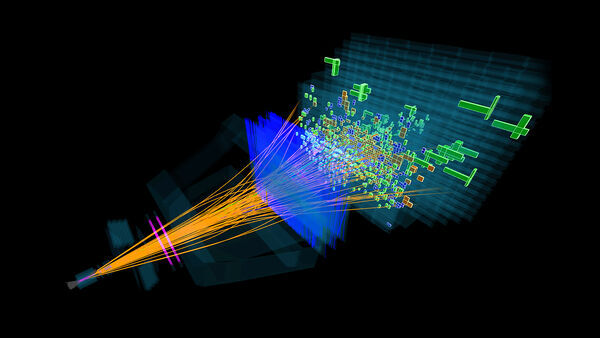
Growing Anomalies at the Large Hadron Collider Raise Hopes
"mid the chaotic chains of events that ensue when protons smash together at the Large Hadron Collider in Europe, one particle has popped up that appears to go to pieces in a peculiar way. All eyes are on the B meson, a yoked pair of quark particles. Having caught whiffs of unexpected B meson behavior before, researchers with the Large Hadron Collider beauty experiment (LHCb) have spent years documenting rare collision events featuring the particles, in hopes of conclusively proving that some novel fundamental particle or effect is meddling with them. In their latest analysis, first presented at a seminar in March, the LHCb physicists found that several measurements involving the decay of B mesons conflict slightly with the predictions of the Standard Model of particle physics — the reigning set of equations describing the subatomic world. Taken alone, each oddity looks like a statistical fluctuation, and they may all evaporate with additional data, as has happened before. But their collective drift suggests that the aberrations may be breadcrumbs leading beyond the Standard Model to a more complete theory." [...]
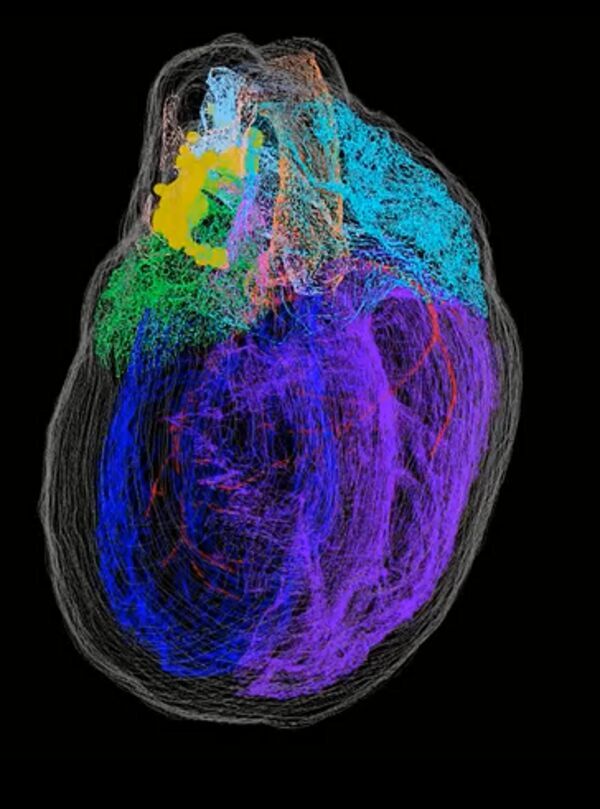
The First 3D Map of the Heart’s Neurons
"An interdisciplinary research team establishes a new technological pipeline to build a 3D map of the neurons in the heart, revealing foundational insight into their role in heart attacks and other cardiac conditions The normal functioning of our hearts is maintained by our body’s control center - the brain - via an intricate network of nerves. When this communication is disrupted, it results in heart disease, including heart attacks, sudden cardiac death and problems in blood supply. As an added layer of safety, the heart has its own ‘little brain’, called the intracardiac nervous system (ICN) to monitor and correct any local disturbances in communication. The ICN is essential in supporting heart health and can even protect cardiac muscle during a heart attack. But it’s not clear how exactly the ICN carries out these roles, because the organization of the neurons that make up the ICN are poorly understood; we don’t know where they are located in the heart, how they are connected to each other, and what their molecular properties are. In a groundbreaking study published in iScience on May 26th, researchers at Thomas Jefferson University and their collaborators have been able to answer these questions in unprecedented detail." [...]
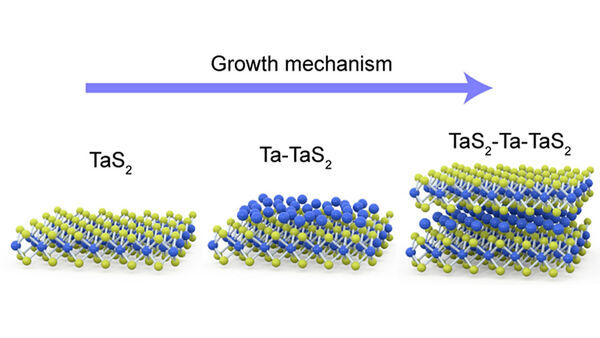
A new library of atomically thin 2D materials
"NUS researchers have created a whole new library of atomically thin, two-dimensional (2D) materials using a novel and powerful approach of engineering the composition of transition metal dichalcogenides. Materials that are atomically thin offer a platform to explore a wide range of intriguing physical properties and could provide many future applications. For example, ‘transition metal dichalcogenide monolayers’ are atomically thin semiconductors which are tipped to bring about the next generation of transistors, solar cells, LEDs, and more. Transition metal dichalcogenide monolayers take the form MX2, with ‘M’ being a metal atom from the transition block of the periodic table and ‘X’ being a chalcogen atom (such as S, Se, or Te). However, fine-tuning the composition of 2D transition metal dichalcogenides to make new materials other than the standard compounds is usually challenging. Now, a research team led by Professor Loh Kian Ping from NUS Chemistry and Professor Stephen J. Pennycook from NUS Materials Science and Engineering, has synthesised and characterised for the first time, an atlas of atomically thin materials based on inserting the same metal atom between two transition metal dichalcogenides monolayers." [...]
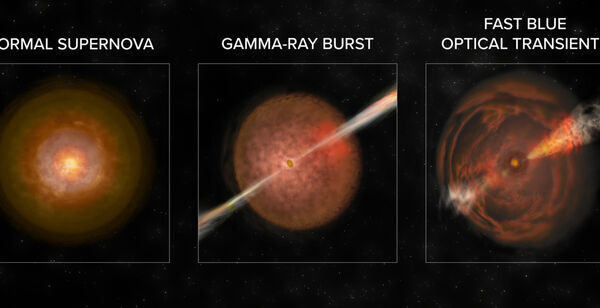
Astronomers Discover New Class of Cosmic Explosions
"Astronomers have found two objects that, added to a strange object discovered in 2018, constitute a new class of cosmic explosions. The new type of explosion shares some characteristics with supernova explosions of massive stars and with the explosions that generate gamma-ray bursts (GRBs), but still has distinctive differences from each. The saga began in June of 2018 when astronomers saw a cosmic blast with surprising characteristics and behavior. The object, dubbed AT2018cow (“The Cow”), drew worldwide attention from scientists and was studied extensively. While it shared some characteristics with supernova explosions, it differed in important aspects, particularly its unusual initial brightness and how rapidly it brightened and faded in just a few days. In the meantime, two additional blasts — one from 2016 and one from 2018 — also showed unusual characteristics and were being observed and analyzed." [...]

Cosmic bursts unveil Universe’s missing matter
"Astronomers have used mysterious fast radio bursts to solve a decades-old mystery of ‘missing matter’, long predicted to exist in the Universe but never detected—until now. The researchers have now found all of the missing ‘normal’ matter in the vast space between stars and galaxies, as detailed today in the journal Nature. Lead author Associate Professor Jean-Pierre Macquart, from the Curtin University node of the International Centre for Radio Astronomy Research (ICRAR), said astronomers have been searching for the missing matter for almost thirty years. “We know from measurements of the Big Bang how much matter there was in the beginning of the Universe,” he said. “But when we looked out into the present Universe, we couldn’t find half of what should be there. It was a bit of an embarrassment.” “Intergalactic space is very sparse,” he said." [...]
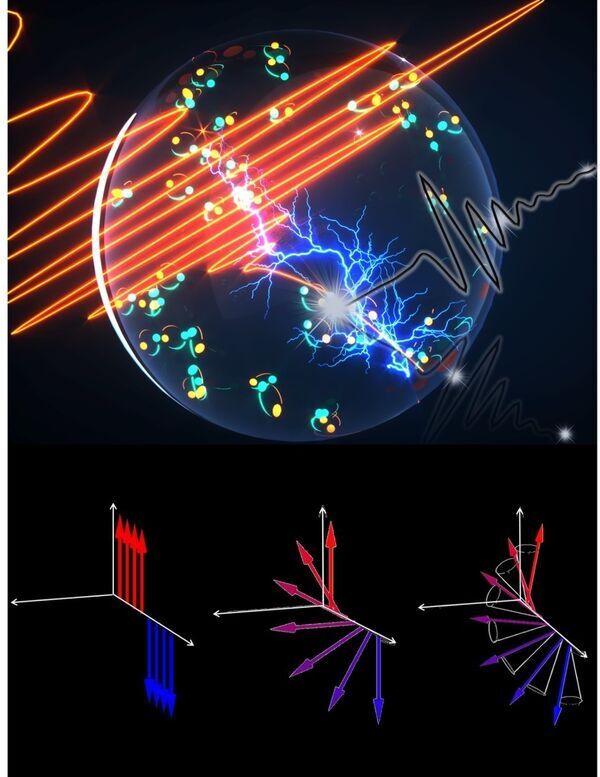
Scientists use light to accelerate supercurrents, access forbidden light, quantum properties
"Scientists are using light waves to accelerate supercurrents and access the unique properties of the quantum world, including forbidden light emissions that one day could be applied to high-speed, quantum computers, communications and other technologies. The scientists have seen unexpected things in supercurrents – electricity that moves through materials without resistance, usually at super cold temperatures – that break symmetry and are supposed to be forbidden by the conventional laws of physics, said Jigang Wang, a professor of physics and astronomy at Iowa State University, a senior scientist at the U.S. Department of Energy’s Ames Laboratory and the leader of the project. Wang’s lab has pioneered use of light pulses at terahertz frequencies– trillions of pulses per second – to accelerate electron pairs, known as Cooper pairs, within supercurrents. In this case, the researchers tracked light emitted by the accelerated electrons pairs. What they found were “second harmonic light emissions,” or light at twice the frequency of the incoming light used to accelerate electrons. That, Wang said, is analogous to color shifting from the red spectrum to the deep blue." [...]
Documentação
A documentação é parte essencial do processo de aprendizagem e a Internet além de artigos interessantes de explorar também tem alguma documentação em formato PDF interessante de ler. Todos os links aqui apresentados são para conteúdo disponibilizado livremente pelo editor do livro.
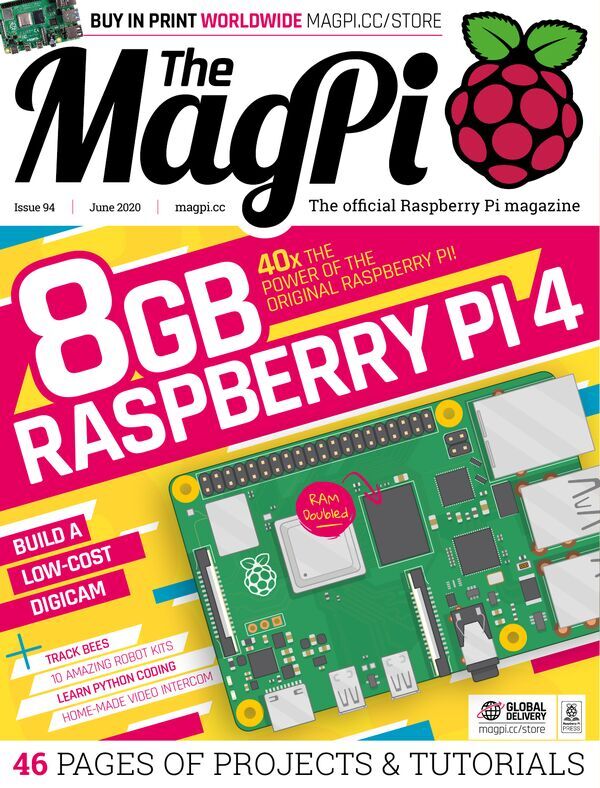
The MagPI 94
"Introducing Raspberry Pi 4 with 8GB RAM. With twice the memory of any previous Raspberry Pi, and 40 times the power of the original board; the new 8GB model is a monster! Discover what you can do with the ultra-powerful Raspberry Pi 4 in this month’s edition of The MagPi magazine. Inside The MagPi magazine #94 - 8GB Raspberry Pi 4. Where to buy and how to make the most of 8GB RAM. Plus!" [...]
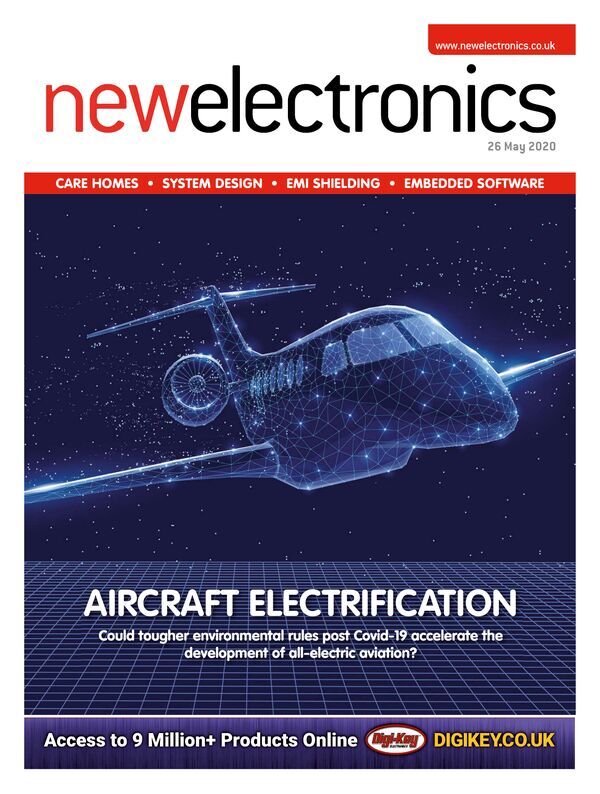
newelectronics 26 Maio 2020
"New Electronics is a fortnightly magazine focusing on technological innovation, news and the latest developments in the electronics sector. Downloadable as a digital page turner or pdf file, or offered as a hard copy, the New Electronics magazine is available in a format to suit you. " [...]
Projetos Maker
Diversos Projetos interessantes.
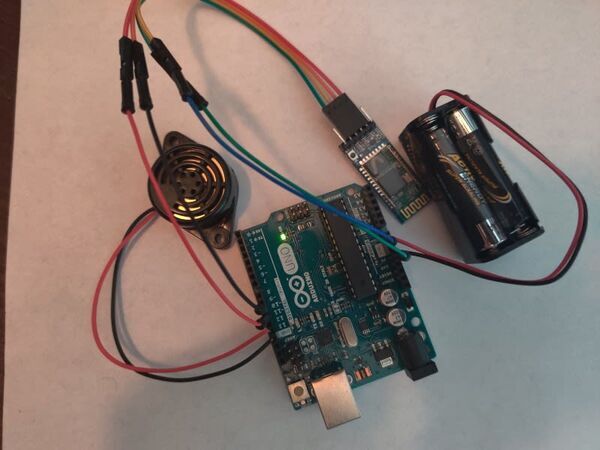
The Internet of Dogs: How to Build a $50 IoT Dog Collar That Locates Your Pet
"I love side projects. They give me the opportunity to flex my creative muscles and tinker with tech like the Internet of Things (IoT) in new ways. Fortunately, I didn't have to look far for my next one; a common conundrum for pet owners fueled this concept for an IoT dog collar. My dog had been out in the backyard for a while. When I decided it was time to bring him back into the house, I couldn't find him anywhere! After several minutes of searching and calling his name, I found him napping in the shade of a tree." [...]
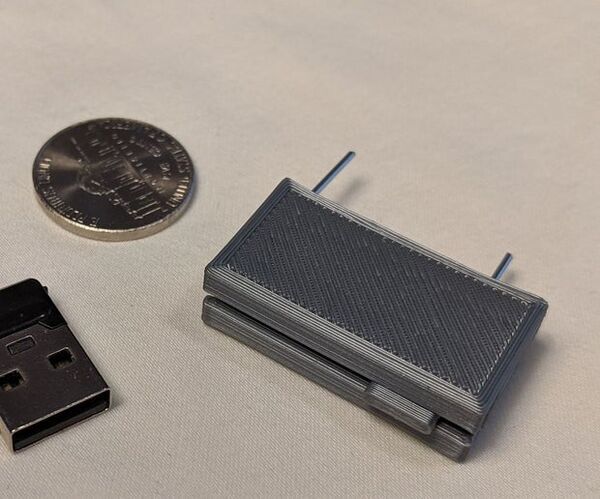
3D-Printed Electric Slide Switch (Using Only a Paperclip)
"I've dabbled in wiring together my own little electrical projects over the years, mostly in the form of paperclips, aluminum foil, and cardboard cobbled together with hot glue. I recently bought a 3D printer (the Creality Ender 3) and went looking for a printable model that would let me create more reliable electrical components using the same common household metal. Most recently I needed an on-off switch that I could wire into a standard 2-pin computer fan being powered by an AC wall adapter. To my dismay, I could find only one printable model that didn't require ordering special metal parts for electronics (Hackaday), and the last update to that project revealed that it stopped working after some light use in 2016. But I thought the core function of their design looked promising, so I decided to take a shot at creating a similar simple electrical switch. After a couple days in Sketchup and several iterations, I've designed a (so far) reliable electrical switch that, besides the printable plastic housing, only requires about half of a large office paperclip for the conductive components." [...]
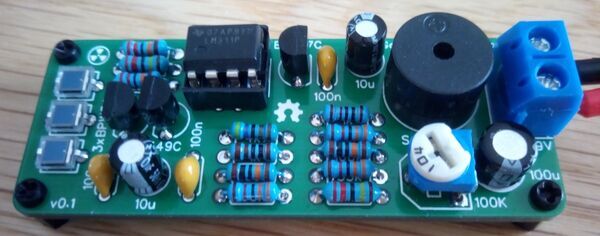
BPW34 Gamma Ray Detector
"The usual approach to radiation detection is the use of a Geiger-Müller tube and its high voltage circuit requirements, but during a quick surf through the internet today, I came across this portable and “accurate looking” solution developed by Stefan Wagner, on EasyEDA. Rather than the Geiger Muller tube and its complex circuitry, the project uses a miniature Silicon PIN Photodiode, the 3x BPW34 (which were connected in parallel to improve sensitivity), as the primary sensing component. The BPW34 is a PIN photodiode with high speed and high radiant sensitivity in miniature, flat, top view, clear plastic package. It is sensitive to visible and near-infrared radiation and has a small sensitive area, which is an advantage in radiation detection, as the background rate due to cosmic rays is very low, and signals from small samples will be easier to detect than when a counter tube is used. The behavior of the BPW34 PIN photodiode used in the project is similar to that of a low-cost counter tube in the sense that, while alpha particles may be stopped by the enclosure of the device, gamma rays due to their high penetration ability will pass through and create electron-hole pairs in the depletion layer of the diode. This will lead to the charge carriers in the diode being drawn away and a small current pulse being created." [...]
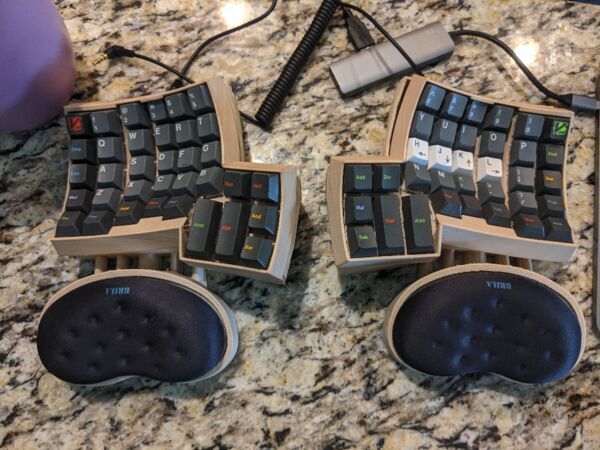
Pterodactyl - the Bluetooth Dactyl Fork
"I spent far too much time making a bluetooth dactyl keyboard with built in wrist rests This took about a year, off and on. With covid I finally found some time to finish it. Build Hardware Base was customized heavily by me from this one. Mine here supports less ugly wrist pads IMO, printed in Wood PLA from hatchbox on a taz6 at 0.1micron height Feather 32u4 TRRS cable MCP 23018 io expander Wrist rests GMK Oblotzky Oblivion V2 caps Holy Panda switches Amoeba single switch PCB’s 1N4148 diodes" [...]
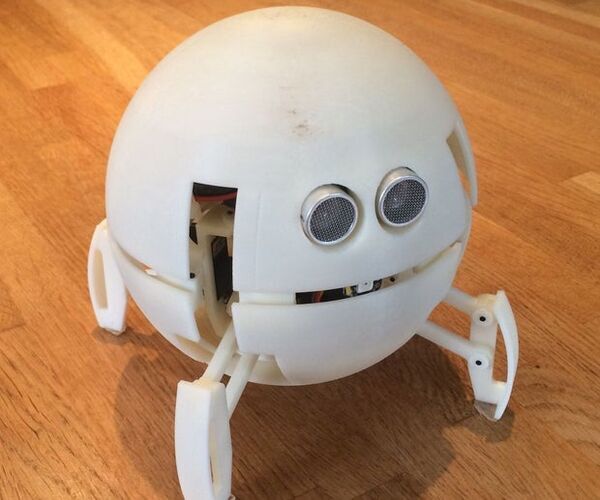
Spherical Quadruped Arduino Robot
"Welcome, Two years ago, by curiosity, I ordered an Arduino starter kit without background on electronic and code. I do not know what happened to me... I battled during the first two weeks to simply blink a led.... Weeks and months later, projects after projects, the pleasure to play with Arduino did not fade away, quite the contrary. I made tangible progress using internet publications, now it is time for me to share my own experience. I am pleased to present my first Instructable." [...]
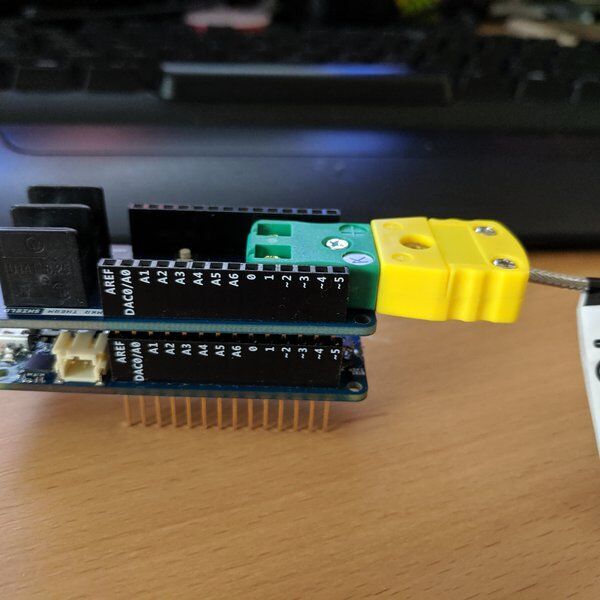
BBQ Thermostat
"A board-controlled temp probe and fan to maintain temperature during a long smoke or BBQ I'd like to make my own version of something like the CyberQ (https://www.bbqguru.com/storenav?CategoryId=1&ProductId=35). There are many commercial products out there that will act as a thermostat for a smoker or BBQ, but if they have a web component it's dependent on the "cloud" and proprietary apps. So I want to make my own so that I control all the data. " [...]
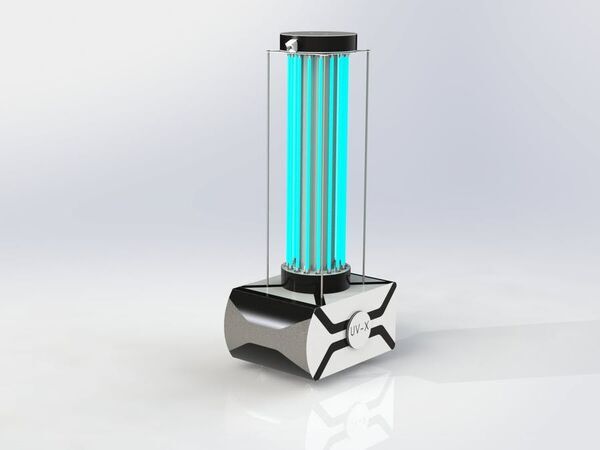
Ultraviolet Germicidal Robot
"A robot to disinfect public places and hospitals in a cost-effective way utilizing ultraviolet lights. Introduction to the Robot Ultraviolet Germicidal Robot (UV Robot) is a teleoperated robot equipped with a UV light system. The system contains a moving robot vehicle and a ground station controller (GCS). The operator can control the robot using the joystick of the ground station controller (GCS) while observing the camera feed of the robot. The robot can disinfect and kill diseases, viruses, bacteria, and other types of harmful organic microorganisms in the environment, with ultraviolet light, by breaking down their DNA-structure. Currently, USA, China and Korea have tested these robots successfully to disinfect their hospitals, public transports, office spaces, and other public places." [...]
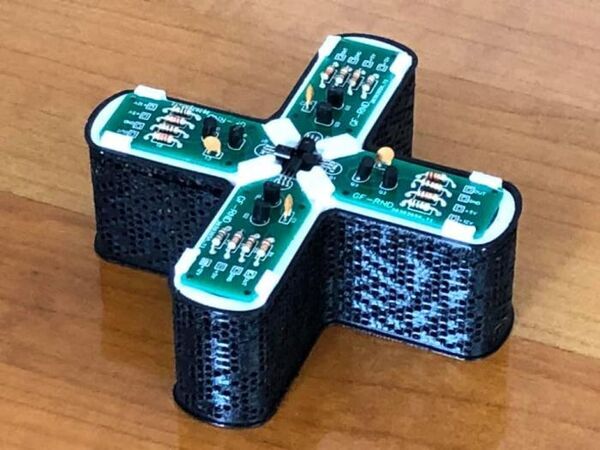
Analog 4-bit random number generator
"As previously reported, I’m on a slow track research project into randomness. Having explored the concept of random bits and built some experimental random electronics, I’m still progressing in my question to understand how randomness can be exploited both for understanding the fundamental process of creation and creativity as well as randomness as a shortcut for complex or even intractable algorithms. I’ve learned a trick over the years: if you don’t understand what you’re doing, keep doing it. On that dirk-gently-esque premise I’ve designed and built a 4-bit analog random number generator. Below is the circuit diagram for one bit; it’s essentially the one as I used in my tests before. I have replaced the schmitt inverter by a transistor with a pull-up resistor." [...]
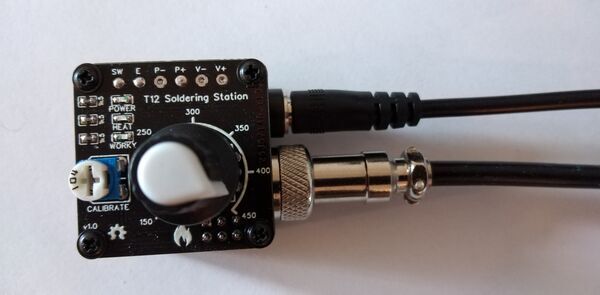
TinySolder - T12 Soldering Station based on ATtiny13a
"TinySolder is a simple T12 Quick Heating Soldering Station based on the ATtiny13a featuring in 700 bytes of code: Temperature measurement of the tip Direct control of the heater Temperature control via potentiometer Handle movement detection (by checking ball switch) Time driven sleep/power off mode if iron is unused (movement detection) Indicator LEDs: steady blue - station is powered steady red - tip temperature has not reached setpoint yet steady green - tip temperature is at setpoint - iron is worky blinking red/green - iron is in sleep mode - move handle to wake up steady red and green - iron is in off mode - move handle to start again For calibration you need a soldering iron tips thermometer. For best results wait at least three minutes after switching on the soldering station before you start the calibration. Calibrate at your prefered temperature using the trimpot. " [...]
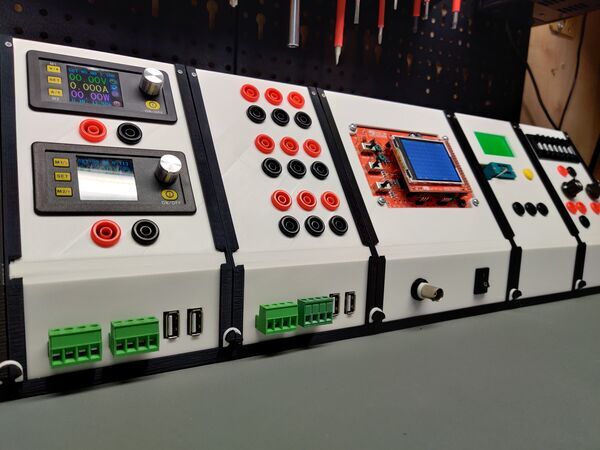
Elelab_v2
"This is a low cost, modular elctronics lab system for hobbyists. The customizable modules include fixed and variable power supplies, measurement tools, component testers and much more. Everything in here is done with open source software, including FreeCAD for all the 3d printable files and KiCAD for the PCBs. I have made a set of modules already and am in the process of creating many more. Raw PCB project files, Gerbers and FreeCAD projects are all uploaded here for your customizing needs, while the finished modules are uploaded to Thingiverse. Please be sure to upload any remix you do as it might be useful for others and especially myself!" [...]
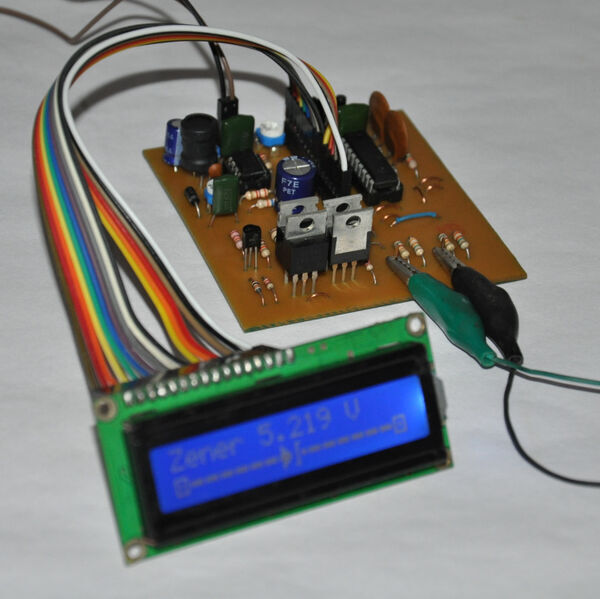
Experimental Zener Diode Tester
"Automatic Zener diode tester is capable of identifying Zener diodes up to 27.5V. Apart from that, it can be used to recognize leads of the diodes/Zeners and detect damaged diodes. This tester is designed using well-known ICs such as MC34063 and PIC16F88. This unit provides approximately 5% to 15% accurate readings. Based on our observations, the accuracy of this unit can increase by using resistors with 1% tolerance, stable booster circuit, accurate sampling method(s), and with a more optimized PCB layout. " [...]

Creating a Videoplayer for ESP32
"One of the things which makes embedded programming so interesting is that you are constantly dealing with restricted resources. Playing video files is quite resource heavy. Let’s see how ESP32 can handle this. If you have short attention span here is a video instead. RAW RGB565 The easiest compression is no compression at all. Embedded displays are often configured to have RGB565 pixel format." [...]
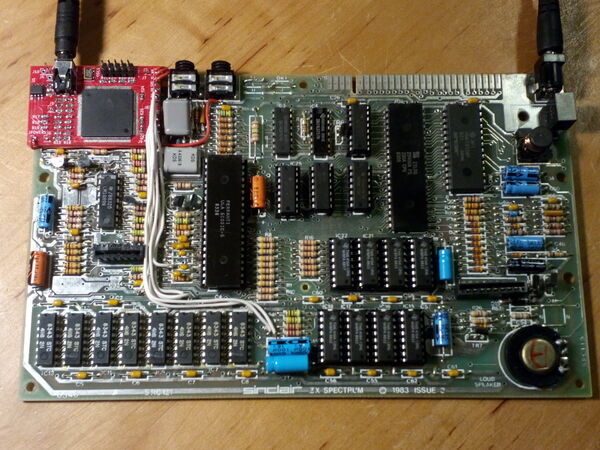
ZX-Spectrum-Component-Video
"Component video (YPbPr) output for the ZX Spectrum computer General The ZX Spectrum in its original form produces a radio frequency signal that can be fed into an analog TV. The quality of this signal is very poor, but this can be improved by a simple modification that will make the ZX Spectrum output a composite video signal instead. While this is actually better, it is nowhere near good. To bring the video quality to the next level, this modification will produce a component video signal (YPbPr) that should be as good as an analog signal can possible get. This video signal can be used either directly with a TV that has a YPbPr input, or it can be passed through a dedicated upscaler device ("Framemeister", "OSSC", etc.) before displaying on an HDMI screen." [...]
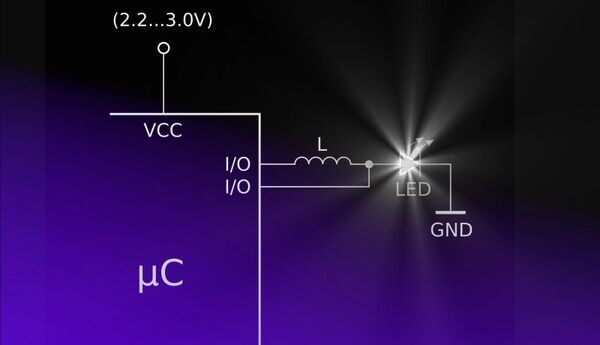
LED Booster for Microcontrollers
"There’s many a time when you want to connect a white LED to a microcontroller operating from a 3 V supply voltage. Unfortunately, this doesn’t work and your nice white LED only lights up feebly or not at all. Why does it work perfectly with red and green LEDs, but not with white? A bit of data sheet research reveals the reason: white LEDs have a forward voltage of 3.2 V, so a 3 V supply is simply not enough to let them light up properly. The advice you often see in online forums is to use a boost converter to generate a higher voltage, along with a transistor switch to control the LED. For just a single LED, this seems like a lot of overhead." [...]
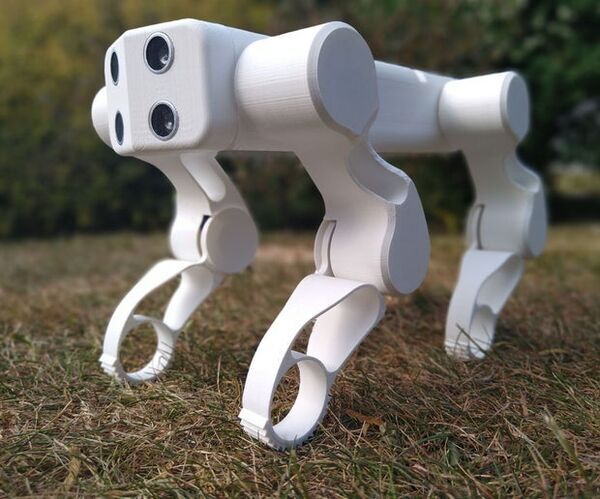
GoodBoy - 3D Printed Arduino Robot Dog
"This instructable details how to make a small quadruped robot using 3D printed parts. It is designed to be compact, simple, and inexpensive to build. This project uses an Arduino Uno as the microcontroller. In this instructable you will find complete 3D model files, Arduino programs, and instructions needed to replicate (and hopefully improve upon) this project for yourself! For a few years I've wanted to make a quadruped robot, having been very much inspired by the extraordinary robots of Boston Dynamics (in particular the 'Spot'). Being in lockdown, I'm lucky to have some time on my hands, and so when less than four weeks ago a friend mentioned to me that there was a 3D-Printing contest, I thought this was a great excuse to try and design a robo-dog for myself!" [...]
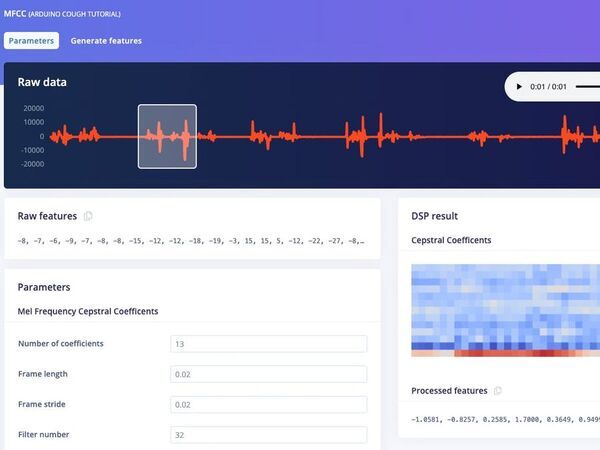
Cough Detection with TinyML on Arduino
"In this tutorial we show how to build a cough detection system for the Arduino Nano BLE Sense using TinyML and Edge Impulse. There is a huge need for inexpensive, easily deployable solutions for COVID-19 and other flu related early detection. Together with the UN, Hackster, Edge Impulse and many others we recently launched the UN Covid Detect & Protect Challenge aiming to create easily deployable solutions for the prevention and detection of flu in developing countries. In this tutorial we show how to use Edge Impulse machine learning on an Arduino Nano BLE Sense to detect the presence of coughing in real-time audio. We built a dataset of coughing and background noise samples, and applied a highly optimized TInyML model, to build a cough detection system that runs in real time in under 20 kB of RAM on the Nano BLE Sense. This same approach applies to many other embedded audio pattern matching applications, for example elderly care, safety and machine monitoring." [...]
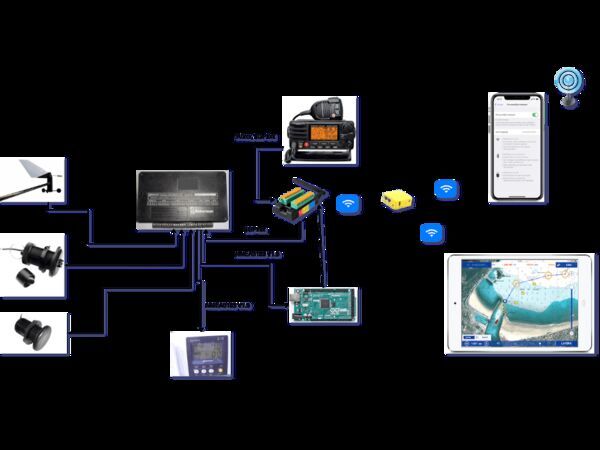
The NMEAtor
"If you can't fix it in software you'll have to fix it in hardware in this case. Hence the NMEAtor. I've an old Robertson data network on board feeding the on board devices with NMEA0183 v1.5. Not only is this RS-232 related, but the NMEA sentences are not terminated with a checksum. Most navigation apps don't care and checksum checking can be overridden by the user. There is how ever a newer NMEA0183 v2.0 related data stream for GPS and AIS information that needs to be integrated with the old data stream, better known as multiplexing." [...]
cVert - A truly random MIDI controller
"cVert is the result of an idea I’ve been kicking around for years, and took a few months of work to bring to fruition. The idea was to use a Geiger counter as a true random number generator to give a non-deterministic input for computer art or music. The result is a MIDI controller with a large amount of control removed - it plays a random musical note every time a radioactive decay is detected. The idea of using radioactive decay to generate random numbers is not especially novel. Geiger-Müller tubes have been used to provide random numbers for many years in hardware random number generators. These are generally used to provide a greater level of security in cryptography, where true randomness is important and pseudorandomness would not be adequate." [...]
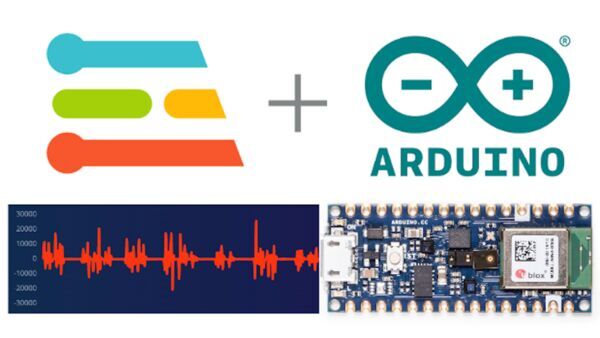
Edge Impulse makes TinyML available to millions of Arduino developers
"Running machine learning (ML) on microcontrollers is one of the most exciting developments of the past years, allowing small battery-powered devices to detect complex motions, recognize sounds, or find anomalies in sensor data. To make building and deploying these models accessible to every embedded developer we’re launching first-class support for the Arduino Nano 33 BLE Sense and other 32-bit Arduino boards in Edge Impulse. The trend to run ML on microcontrollers is called Embedded ML or TinyML. It means devices can make smart decisions without needing to send data to the cloud – great from an efficiency and privacy perspective. Even powerful deep learning models (based on artificial neural networks) are now reaching microcontrollers. This past year great strides were made in making deep learning models smaller, faster and runnable on embedded hardware through projects like TensorFlow Lite Micro, uTensor and Arm’s CMSIS-NN; but building a quality dataset, extracting the right features, training and deploying these models is still complicated." [...]
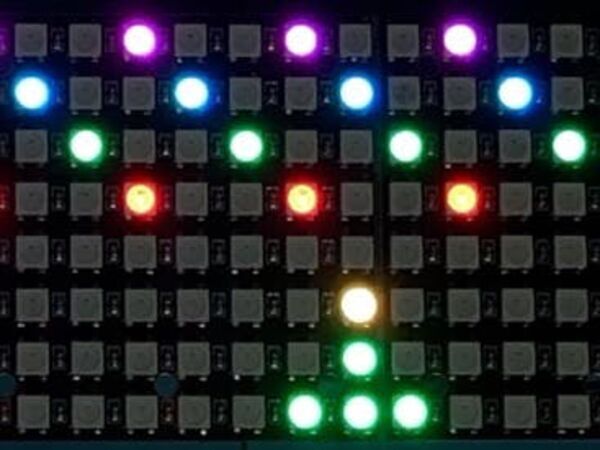
Space Hinvaders Color
"A micro game with Color LED matrix where the pixels used for the entire game are about those of a single sprite of the original invader. I really like old video games, and I had never found a space invader style game on Arduino that used Dot matrix LED display. One day seeing one of these displays I said to myself: I could make a space invader in a space approximately equal to what was originally occupied by a single sprite of an invader. It would be great. I got started and tried it, and in spite of all the limitations I managed to do something playable and at the same time fascinating considering the limits of the hardware.As you can see on the title is named Space Hinvaders, because is a Survival Hacking (SH) creation, so altered original Space Invader name according to SH Initials. This is an enacted version, that's add a color WS2812 RGB dot matrix display to the original project https://www.hackster.io/davide-gatti/space-hinvaders-c48731 based on MAX7219 Red LED dot matrix display." [...]
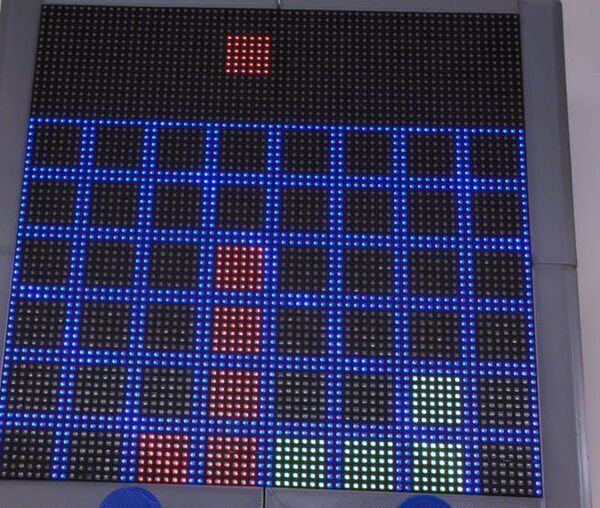
Play Virtual Connect Four on an LED Matrix
"Use a 64x64 LED matrix, along with a couple of encoders and a button, to play Connect Four against an opponent in real-time. Building upon my previous project, the Pix-A-Sketch, I created a way to play a game of connect four using a 64 x 64 LED matrix. It emulates an 8x6 grid in which two people can place yellow and red chips by rotating a pair of a rotary encoders and pressing a button. " [...]
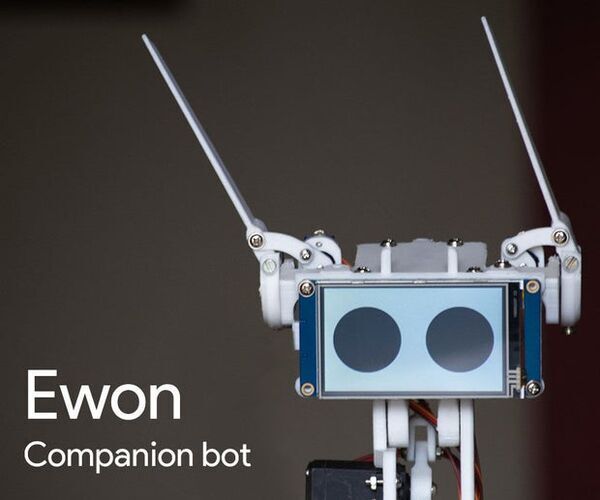
EWON Raspberry Pi Powered Home Robot
"I recently found myself binge-watching a lot of Netflix series due to the current situation, I hope you all are safe, and I saw that season 5 of the Black Mirror was released. An anthology series that revolves around a group of people's personal lives and how technology manipulates their behavior. And one of the episodes that caught my attention was Rachel, Jack, and Ashley Too. One of the main characters of this series is a home robot named Ashley O and that robot has a lot of character around it and I thought for myself I should build one, it's a good project to getting started with programming if not that then at least I can program it to laughs at my jokes.! What / Who is Ewon? What can it do?" [...]
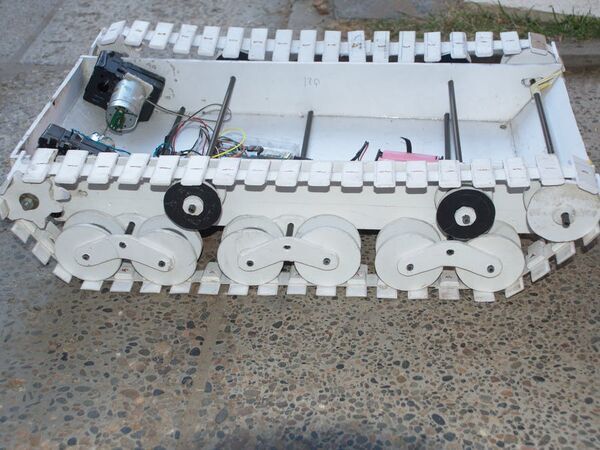
EscoriaBot
"EscoriaBot is a robot made with recycled material and Arduino electronics. Since I saw R2-D2 more than 40 years ago in my childhood I wanted to have a robot. But there was a great barrier between me and my dreams, the Electronics and this problem remained for many more years. As a user, an advocate of free software, I had heard of arduino but it seemed too difficult for me until my friend Gustavo helped me choose my first kit. I put it together and kept going. I did not like the chassis because it was stuck with any obstacle I decided to make my own chassis And it worked but I wanted something more powerful So I started looking for alternatives and researching I found several YouTube channels such as The Post Apocalyptic Inventor or Espacio de César where I realized that I could take advantage of many discard devices and incidentally make the planet cleaner." [...]
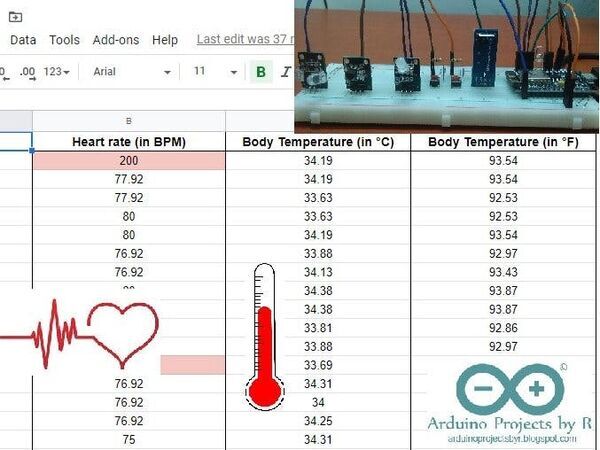
COVID-19 Remote Health monitoring system ( IoT )
"A cost-effective and open source system to data log health measurements in Google sheets and allows the doctor to monitor them from anywhere Coronavirus disease, also known as COVID-19, is an infectious disease which spreads between humans. The incubation period of coronavirus is on average 5 - 6 days, but it could also be up to 14 days. During this incubation period, before the person begins experiencing symptoms, the person could be contagious. The virus would spread to the people with whom the infected person is interacting, and this is dangerous. The presence of coronavirus in a human's body could be tested by carrying out PCR tests. The demand for PCR tests is increasing, but the tests cannot be carried everywhere." [...]
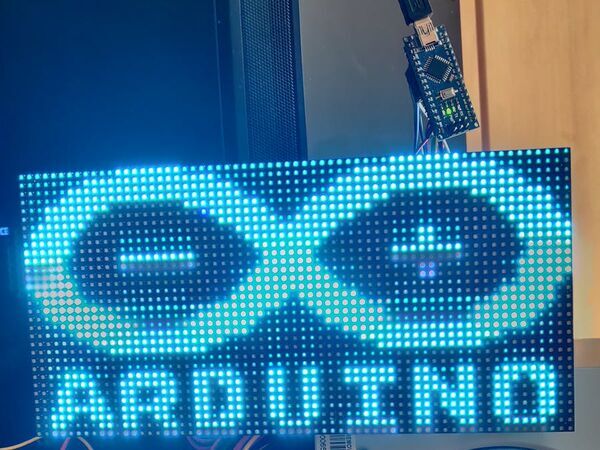
Running a 32x64 RGB LED Panel with only an Arduino Nano
"Display any picture or text on a 32x64 LED panel with just an Arduino Nano! The beginning The actual first time I worked with such a panel was on the 36C3 in the end of 2019, when a friend of mine tried to get them running with an esp32. I wanted to also do some fun things with such a panel, so I got myself a 32x64 P.3 RGB LED panel. January 22nd, I got this panel in the mail, and having no other controller on my hand back then I just wanted to get it working with the NANO. I've seen many libraries and projects with the UNO and a 16x32 panel, but everything this size was always run by a teensy or a pi. I looked for Libraries, but couldn't find any." [...]
That's all Folks!



